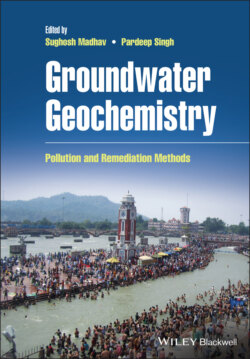Читать книгу Groundwater Geochemistry - Группа авторов - Страница 17
1.3 Fluoride
ОглавлениеFluorine is highly electronegative in nature and cannot stand isolated in the environment due to its high reactivity. It occurs in the form of oxides in the natural system with the oxidation state of −1. It presents in water as fluoride. Fluoride occurrence in groundwater is predominantly geogenic in nature. Fluoride comes in groundwater by the dissolution of F‐bearing rocks, as well as anthropogenic pollution. Fluorite (CaF2), fluore‐apetite (Ca5(PO4)3F and apatite Ca(PO4)3(F/OH/Cl), hornblende Ca2(Mg,Fe,Al)5(Al,Si)8O22(O.H.,F)2, and biotite K(Mg,Fe)3(AlSi3 O10) (F,OH)2 in gneisses are important fluoride‐bearing minerals. Moreover, fluorine may also present as the constituent of clay minerals and through rock–water interaction it liberates as fluoride into the subsurface water (Raju et al. 2009; Banerjee et al. 2011). Moreover, leaching of fluoride depends on the alkalinity of the groundwater (Brindha and Elango 2011). In the alkaline environment, the leaching of fluoride will be higher; the alkaline environment is attributed to the dissolution of silicate minerals and the leaching of organic matters from the soil layer (Hoque et al. 2000). Some amount of fluorides may occur in groundwater because of mineral fluorite (CaF2) dissolution. The reaction is given below (Helgeson 1969):
If the aquifer system has a high mineral content of calcite, it also supports fluoride dissolution from the fluoride‐rich minerals. Therefore F− will release in water if soil and groundwater have lower calcium content (Kundu and Mandal 2009; Brindha and Elango 2011). The factors that influence the fluoride concentration in groundwater include fluoride‐bearing minerals, pH, temperature, anion exchange capacity of aquifer media (O.H.− for F−), residence time, porosity, soil structure, depth, groundwater age, and bicarbonates (Grützmacher et al. 2013). The fluorine concentration varies in different rock types such as the igneous rocks (100–>1000 ppm), sedimentary rocks (100 ppm in limestone to 1000 ppm in shales), and in metamorphic rocks (up to 5000 ppm) (International Groundwater Resources Assessment Centre, Report nr. SP 2004‐2). Apart from this it leaches from the agricultural activities through phosphatic fertilizers and from the effluents of the ceramic industries in which cay has been used, as well as is present in high amounts in the flying ash from the burning of coal. In geological material, the median fluoride concentration present in the sequence of metamorphic rocks ≥ granitoid ≥ complex rock (Manikandan et al. 2014). Besides geogenic sources, phosphatic fertilizer, cow dung, industrial effluents, and other urban waste are responsible for the fluoride in groundwater (CGWB 2014).
